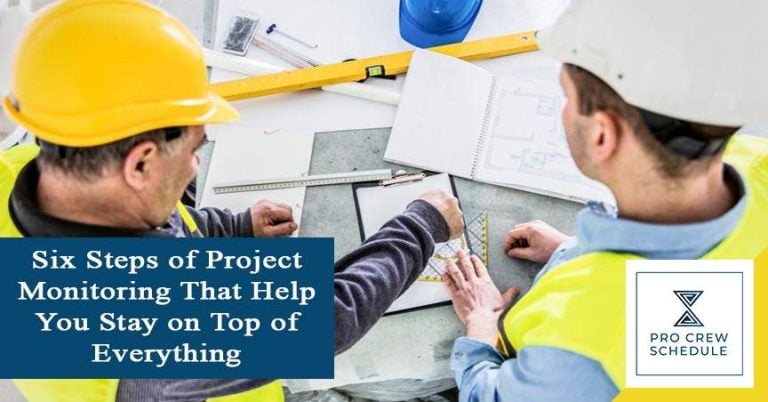Project monitoring in construction involves ensuring that the delivered project matches the time and budget constraints that the client and the contractor agreed upon. Monitoring construction progress also ensures that the work and output match the plans and specifications. The site must be monitored often to confirm the line item percentage of construction work done during the progress billings, completion, and acceptance.
As a result, project monitoring is an integral part of how contractors make decisions and manage construction projects. Although project monitoring is often overlooked, it can help the project manager and his team see potential risks and roadblocks that, if not dealt with, could lead the project in the wrong direction. This article discusses construction project monitoring, its types, benefits, and phases.
What is Project Monitoring for Construction Companies?
In a nutshell, project monitoring keeps track of and keeps an eye on everything that is happening within the project and your organization. The project manager is responsible for handling the situation, finding potential problems, and taking corrective actions. You should keep a meticulous approach to all details from project planning, construction schedule, and close-out. This project management phase ensures that the project stays within its scope and meets the set deadlines and budget. It should be done simultaneously with the rest of the project for helpful information about the project.
Why Having a Cohesive Project Monitoring Plan Essential to Your Company’s Success?
When project managers make essential decisions without verified data, it’s like walking into a dark room they don’t know with their eyes closed. Even with something as simple as task project management or complex activities such as risk management, you might use few or no facts to make decisions. So, the action might not be very effective and waste time and money.
Because of this, it is necessary to maintain a careful eye on projects and make informed business decisions based on the information gathered. This section has outlined six advantages obtained by utilizing an integrated monitoring plan for a project.
Ensures Each Project Aligns with the Plan
Keep an eye on how the project will help determine if it is going according to the plan. This way, you can figure out any possible problems or obstacles that can cause the project to veer off course. It gives an overview of your project against your time, quality, and budget baselines.
Keeps Everyone Involved and Engaged
Project monitoring aids and promotes stakeholder engagement. When everyone has access to the same up-to-date information, it enables an approach to the construction process that is more open, collaborative, and integrated.
Guarantees Customer Satisfaction
When people consistently communicate and give each other feedback, it is more likely that the result will guarantee satisfaction and meet expectations, ensuring successful outcomes.
Increases Team Motivation
When the team has clear goals for the project, it increases accountability. It allows them to take a proactive approach to finish their activities and tasks. They will be more motivated if they can keep track of progress and complete the milestones.
Communicating With Suppliers and Trade Partners
Communication is essential, especially when working with outside suppliers and trade partners. By keeping an eye on how well these resources are doing, you can ensure that critical deadlines are met, that the given budget is managed and that any unexpected delays in project planning are considered.
Strive For Continuous Learning and Improvement
Project monitoring is a great way to keep learning, improving, planning, and putting projects into action. Once the project is done, it is essential to write down all the learnings, struggles, and solutions that happened. With this data, you can learn and improve your process for more streamlined and optimized project delivery.
Seven Types of Project Monitoring
Project monitoring can be divided into different types based on the assessment’s purpose, focus, timing, and audience. Since there are many moving parts in construction projects, keeping track of everything might be challenging. Luckily, many project management tools can revolutionize the way you handle projects. In this section, let us look into the seven types of project monitoring.
Process monitoring
Process monitoring is also known as “activity monitoring,” which involves monitoring the construction progress from start to finish. Its scope only involves project tracking – how inputs and resources are used and looking at how activities and outputs are done.
Compliance monitoring
Compliance monitoring ensures that the client’s rules, grants, contract requirements, local government rules and laws, ethical standards, and, most importantly, the project’s expected results are met.
Context monitoring
Context or situation monitoring keeps track of the big picture of how the project works. It includes the project’s institutional, political, financial, and policy context and helps us find and measure risks, assumptions, and other unplanned events. It helps us find these problems early enough to change whether a project succeeds or fails.
Beneficiary monitoring
Beneficiary Monitoring involves tracking how people who directly and indirectly benefit from a project feel about it. It shows how happy or unhappy your stakeholders are with the project and its parts. This includes their participation, treatment, access to resources, whether they are fair, and how they feel about the change.
Financial monitoring
Finding out how efficiently a project spends money is the primary objective of the financial monitoring process. It keeps track of how much the project costs compared to the amount of money that was set aside without sacrificing the quality of the product.
Organizational monitoring
Organizational monitoring keeps track of institutional development, communication, collaboration, sustainability, and capacity building within an organization and its partners and stakeholders as they work on a project.
Results monitoring
This is where evaluation and monitoring come together. It gathers information to show how a project affects the target population. It helps the project team figure out if the project is going in the right direction and if there could be any unintended effects.
The Six Steps of Project Monitoring
Now that we have discussed project monitoring and why it is vital to ensure a smooth and seamless construction process, it is time to know its seven phases. In this section, let us discuss what makes an efficient project monitoring system.
Identify Your Project’s Goals
Start with identifying what you want to achieve with the project. You will have to focus on your project planning phase and create your baselines – time, budget, and scope.
Define Your Key Results Areas
After the project’s objectives have been outlined, it is time to begin discussing how to track and evaluate progress. You will need to establish your construction milestones in order to determine your desired level of accomplishment within a given time frame.
Determine Your Data Collection Methods
Now comes the time to decide how the data will be collected and how often it will be collected. The method chosen will have significant effects on how the project is tracked. Luckily, there are modern solutions to these problems, including construction management software.
Identify Key Roles and Responsibilities
You need to decide who will be in charge of the data collection for each progress indicator. It is necessary to establish clear roles for handling data for everyone to be on the same page.
Create Analysis Plans and Reports
After you have collected all of the data, you will need to create a results table for internal review and a report to send out to the rest of the globe. Therefore, the strategy for monitoring the project has to clarify what data will be examined and how the results will be presented. It ought to be articulated in a manner that is concise and unmistakable.
Document Everything
Documentation lays down the foundation for quality, traceability, and history. The documentation must be clear, well-organized, and complete. Proper project documentation is a must for managing and monitoring projects. Still, it is also beneficial for keeping projects moving quickly, ensuring that all stakeholders are as informed as possible, and helping the organization figure out how to improve future projects.
How Construction Management Software Can Help You Keep Track of Everything
Setting project goals and objectives help you monitor your project’s progress. This phase in project management is often the most tedious and laborious. As such, it usually requires the correct tools. Teams can be more productive when they know their goals rather than merely executing duties. Monitoring and evaluating a project lets you find and fix problems that might affect the project’s scope, quality, schedule, or budget. Construction management software allows you and your team to input and access data with just a few simple clicks – ensuring real-time information and everyone is on the same page. Everyone can see everything at a high level, all in one place. This software reduces meetings and delays, allowing project managers to focus their time on something more productive.







